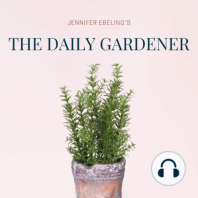8 min listen

August 2, 2019 Going to Seed, Thomas Gainsborough, Hawaiian Potatoes, Franklinia, Wallace Stevens, William Watson, The Cook and the Gardener by Amand…
August 2, 2019 Going to Seed, Thomas Gainsborough, Hawaiian Potatoes, Franklinia, Wallace Stevens, William Watson, The Cook and the Gardener by Amand…
ratings:
Length:
10 minutes
Released:
Aug 2, 2019
Format:
Podcast episode
Description
Right about now you might be thinking about doing a little garden cleanup and preparation for fall. One of the questions I get from gardeners this time of year has to do with whether or not to let some of your plants go to seed. After spending most of the summer deadheading and illuminating all of the brown stuff on our foliage, it can be tough for some gardeners to let things go to seed. But there are many benefits to letting some of the plants in your garden bolt in all their glory. First of all, there is tremendous ornamental value that extends into winter if you allow your perennials to keep their seed heads. (Think of the seeds heads offered by cilantro, kale, arugula, basil and so forth). Second, seeds offer food and habitat to native bees and other creatures. Thirdly, saving seeds from the garden saves you money because it eliminates the need to buy seed for next year. (Think of your tomatoes and other edibles). This practice also allows you to keep heritage plants alive for future generations. That’s exactly how the heirlooms we know and love have been passed down through the generations. The main thing, is to allow nature to do most of the drying for you. Your seeds will have a much higher success rate if you let them dry as much as possible before you collect them. And finally, allowing plants to go to seed means that you will have less to plant and subsequent seasons thanks to volunteer plants. Each year my garden is blessed with Queen Anne’s lace, Indian Paintbrush, Columbine, Forget-Me-Nots, Lettuce, Dill, Foxglove, Valerian, Lovage and Beets. All planted by God; all perfectly placed and happy as a result. My volunteers find a way to utilize the tiniest nooks and crevices in my garden. Brevities #OTD It’s the anniversary of the death of the landscape and portrait painter Thomas Gainsborough who died on this day in 1788. Gainsborough is known for his painting of the Blue Boy today. You can visit Gainsborough’s house in Suffolk. There is a garden there with a spectacular mulberry tree dating to the early 1600s during the reign of James I who encouraged the planting of mulberry trees in order to establish a silk industry. The king and his advisers lacked the knowledge about Mulberry trees of which there are two kinds. The white mulberry feeds silk worms and the black supplies the fruit. Gainsborough’s Mulberry (as well as every other Mulberry cultivated in England) was the black Mulberry. Although England never successfully became known for silk worms, the craft of silk weaving became firmly rooted. In addition to the large Mulberry, the Gainsborough garden includes two Beds for Herbs and another that is strictly devoted to plants used for dying fabric. The rest of the garden is made up of plants that were available during Gainsborough's lifetime. #OTD Today in 1820 the first potatoes were planted in Hawaii. Turns out the, the American brig, the Thaddeus, brought more than the first missionaries to the island brought. #OTD On this day In 1938, the Belvedere Daily Republican, out of Belvedere Illinois, published a small article about a tree named for Benjamin Franklin. Here’s what it said: "About 200 years ago, John Bartram, an eminent botanist, discovered a strange flowering tree in a Georgia forest and named it "Franklinia" in honor of his fellow Philadelphian, Benjamin Franklin." #OTD It’s the anniversary of the death of the poet Wallace Stevens who died on this day in 1955. Stevens said, "Death is the mother of beauty. Only the perishable can be beautiful; which is why we are unmoved by artificial flowers." Stevens was one of the most skilled poets of the 20th Century he lived his entire adult life near Elizabeth Park in Hartford Connecticut. By day, Stevens worked at Hartford insurance company where he became a Vice President and by night he was a poet; it was in an unusual combination. Stevens lived 2 miles from his work and he walked to work ev
Released:
Aug 2, 2019
Format:
Podcast episode
Titles in the series (100)
The Daily Gardener Podcast Trailer: The show will start Monday, April 1st. The show is called The Daily Gardener. The Daily Gardener is a weekday show (M-F) - weekends are for rest, family, fun, & gardening! Shows are between 5 - 10 minutes in length. The format for the... by The Daily Gardener